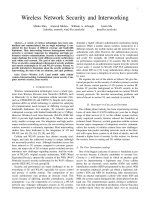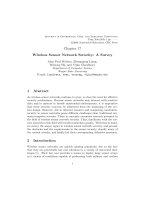Wireless Network Security Part II potx
Bạn đang xem bản rút gọn của tài liệu. Xem và tải ngay bản đầy đủ của tài liệu tại đây (838.6 KB, 28 trang )
J. Wang. Computer Network Security Theory and Practice. Springer 2008
Chapter 6
Wireless Network Security
Part II
J. Wang. Computer Network Security Theory and Practice. Springer 2008
Chapter 6 Outline
6.1 Wireless Communications and 802.11 WLAN Standards
6.2 WEP: Wired Equivalent Privacy
6.3 WPA: Wi-Fi Protected Access
6.4 IEEE 802.11i/WPA2
6.5 Bluetooth Security
6.6 Wireless Mesh Network Security
J. Wang. Computer Network Security Theory and Practice. Springer 2008
WPA:
A rush solution to the security problems of WEP
WPA2:
Based on 802.11i (official version)
Encrypt and authenticate MSDUs: counter mode-CBC MAC
protocol with AES-128
Authenticate STAs: 802.1X
Initialization vectors transmitted in plaintext are no
longer needed to generate per-frame keys
But most of the existing Wi-Fi WPA cards cannot be
upgraded to support 802.11i
WPA 2 Overview
J. Wang. Computer Network Security Theory and Practice. Springer 2008
Key Generation
Same key hierarchy as WPA
256-bit pairwise master key (PMK)
Four 128-bit pairwise transient keys (PTKs)
384-bit temporal key for CCMP in each session
Pseudorandom number generated based on SMAC,
SNonce, AMAC, Anonce
Exchanged following the 4-way handshake protocol
Divided into three 128-bit transient keys:
Two for connection between STA and AP
One as a session key for AES-128
J. Wang. Computer Network Security Theory and Practice. Springer 2008
Encryption:
Ctr = Ctr0
Ci = AES-128K (Ctr + 1)
⊕
Mi
i = 1, 2, …, k
Authentication and integrity check:
Ci = 0
128
Ci = AES-128K (Ci–1
⊕
Mi)
i = 1, 2, …, k
CCMP Encryption and MIC
J. Wang. Computer Network Security Theory and Practice. Springer 2008
802.11i Security Strength and
Weakness
Cryptographic algorithms and security mechanism are superior to WPA and WEP
However, still vulnerable to DoS attacks:
Rollback Attacks
RSN devices can communicate with pre-RSN devices
Attacker tricks an RSN device to roll back to WEP
Let RSN APs decline WEP or WPA connections???
J. Wang. Computer Network Security Theory and Practice. Springer 2008
802.11i Security Weakness
RSN IE Poisoning Attacks
Against 4-way handshake protocol
Attacker can forge message with wrong RSN IE
and disconnects STA from AP
De-Association Attacks
Break an existing connection between an STA and
an AP using forged MAC-layer management
frames
J. Wang. Computer Network Security Theory and Practice. Springer 2008
Chapter 6 Outline
6.1 Wireless Communications and 802.11 WLAN Standards
6.2 WEP
6.3 WPA
6.4 IEEE 802.11i/WPA2
6.5 Bluetooth Security
6.6 Wireless Mesh Network Security
J. Wang. Computer Network Security Theory and Practice. Springer 2008
Proposed in 1998 as an industrial standard
For building ad hoc wireless personal area networks (WPANs)
IEEE 802.15 standard is based on Bluetooth
Wireless devices supported:
Different platforms by different vendors can
communicate with each other
Low power, limited computing capabilities and power
supplies
Implemented on Piconets
Overview
J. Wang. Computer Network Security Theory and Practice. Springer 2008
Self-configured and self-organized ad-hoc wireless networks
Dynamically allow new devices to join in and leave ad-hoc network
Up to 8 active devices are allowed to use the same physical
channel
All devices in piconet are peers
One peer is designated as master node for synchronization
The rest are slave nodes
MAX 255 devices connected in a piconet
Node’s state: parked, active, and standby
A device an only belong to one piconet at a time
Bluetooth: Piconets
J. Wang. Computer Network Security Theory and Practice. Springer 2008
Scatternet schematic
Scatternets: Overlapped Piconets
J. Wang. Computer Network Security Theory and Practice. Springer 2008
Nodes in the same piconet share the same personal identification number (PIN)
Nodes generate share secret key for authentication
Generates a 128-bit initialization key based on the PIN
Generates a 128-bit link key (combination key) to authenticate
and create encryption key
Uses a stream cipher E0 to encrypt payload
Uses a block cipher SAFER+ to construct three algorithms E1, E21, and E22 for generating subkeys and
authenticating devices
Secure Pairings
J. Wang. Computer Network Security Theory and Practice. Springer 2008
To Authenticate Bluetooth device
An enhancement of SAFER (Secure And Fast Encryption Routine)
A Fiestel cipher with a 128-bit block size
Two components:
Key scheduling component
Encryption component
Eight identical rounds (two subkeys for each round)
An output transformation (one subkey)
SAFER+ Block Ciphers
J. Wang. Computer Network Security Theory and Practice. Springer 2008
K = k0 k1 …k15, a 128-bit encryption key.
k16 = k0
⊕
k1
⊕
…
⊕
k15
17 128-bit subkeys K1, K2, …, K17:
SAFER+ Subkeys
K
1
k
0
k
2
k
3
…k
15
for j = 0,1,…,16 do
k
j
<- LS
3
(k
j
)
K
2
k
1
k
2
k
3
…k
16
xor
8
B
2
for i = 3, 4, …, 17 do
for j = 0,1,…,16 do
k
j
LS
3
(k
j
)
K
i
k
i-1
k
i
k
i+1
…k
16
k
0
k
1
…k
i-3
xor
8
B
i-3
B
i
: a bias vector
B
i
[j] = (45
45
17i+j+i
mode 257
)
mod 257) mod 256
j = 0,1,….,15,
B
i
= B
i
[0] B
i
[1] … B
i
[15]
i = 2,3,….17,
J. Wang. Computer Network Security Theory and Practice. Springer 2008
Schematic of SAFER+ subkey generation
J. Wang. Computer Network Security Theory and Practice. Springer 2008
SAFER+ Encryption
Encryption Rounds
Let X = x1x2…x2k-1x2k, where xi is a byte
Pseudo Hadamard Transform (PHT):
PHT(X) = PHT(x1,x2)||…||PHT(x2k-1, x2k)
PHT(x,y) = (2x+y) mod 2
8
|| (x+y) mod 2
8
Armenian Shuffles (ArS):
ArS (X) = x8x11x12x15x2x1x6x5x10x9x14x13x0x7x4x3
where X is a 16-byte string
Table look up on two S-boxes for e and l:
e(x) = (45
x
mod (2
8
+ 1)) mod 2
8
l is e
-1
: l(y) = x if e(x) = y
⊕ and ⊕
8
with two subkeys
The i-th round in SAFER+:
J. Wang. Computer Network Security Theory and Practice. Springer 2008
Output Transformation:
After eight rounds, the output transformation component applies K
17
and Y
9
as applying K
2i-1
to Y
i
without using S-box and generate ciphertext block C.
J. Wang. Computer Network Security Theory and Practice. Springer 2008
Bluetooth Algorithm E
1
E1 takes the following parameters as input:
K: 128-bit key
ρ
: 128-bit random string
α
: 48-bit address
and outputs a 128-bit string:
Ar is original SAFER+
is modified SAFER+, which combines the input of round 1 to the input of round 3 to make the algorithm
non-invertible
is obtained from K using
⊕
and
⊕
8
(see p. 238)
E(
α
) =
α
||
α
||
α
[0:3]
J. Wang. Computer Network Security Theory and Practice. Springer 2008
E21 takes
ρ
and
α
as input:
E21 (ρ, α) = A’r (ρ’, E(α))
ρ’= ρ[0:14]|| (ρ[15]
⊕
00000110)
Bluetooth Algorithm E21
J. Wang. Computer Network Security Theory and Practice. Springer 2008
Bluetooth Algorithm E22
J. Wang. Computer Network Security Theory and Practice. Springer 2008
Initialize Key:
Kinit = E22 (PIN, In_RANDA, BD_ADDRB)
DA and DB create link key:
DA sends (LK_RANDA
⊕
Kinit ) to DB
DB sends (LK_RANDB
⊕
Kinit ) to DA
KAB = E21(LK_RANDA , BD_ADDRA)
⊕
E21(LK_RANDB , BD_ADDRB)
DA authenticates DB:
DA sends AU_RANDA to DB
DB sends SRESA to DA where
SRESA = E(KAB , AU_RANDA, BD_ADDRB) [0:3]
DA verifies SRESA
Bluetooth Authentication
J. Wang. Computer Network Security Theory and Practice. Springer 2008
Bluetooth Authentication Diagram
J. Wang. Computer Network Security Theory and Practice. Springer 2008
PIN Cracking Attack
Malice intercepts an entire pairing and authentication session between devices DA and DB
J. Wang. Computer Network Security Theory and Practice. Springer 2008
Malice cracks the PIN by brute force:
Enumerate all 2
48
possible values of PIN
Use IN_RANDA from Message 1 and BD_ADDRB to compute a candidate:
K’init= E22 (PIN’, In_RANDA, BD_ADDRB)
Use K’init to XOR Message 2 and Message 3 to obtain LK_RAND’A and LK_RAND’B. Then compute
K’AB = E21(LK_RAND’A , BD_ADDRA)
⊕
E21 (LK_RAND’B , BD_ADDRB)
Use AU_RANDA from Message 4, K’AB, and BD_ADDRB to compute
SRES’A = E1(AU_RANDA, K’AB, BD_ADDRB) [0:3]
Verify if SRES’A = SRESA using Message 5
May use Messages 6 and 7 to confirm the PIN code
PIN Cracking Attack
J. Wang. Computer Network Security Theory and Practice. Springer 2008
A new pairing protocol to improve Bluetooth security
Secure simple pairing (SSP) protocol:
Use elliptic-curve Diffie-Hellman (ECDH) key exchange algorithm to replace PIN
To resist PIN cracking attack
Use public key certificates for authentication.
To prevent man-in-the-middle attack.
Bluetooth Secure Simple Pairing









